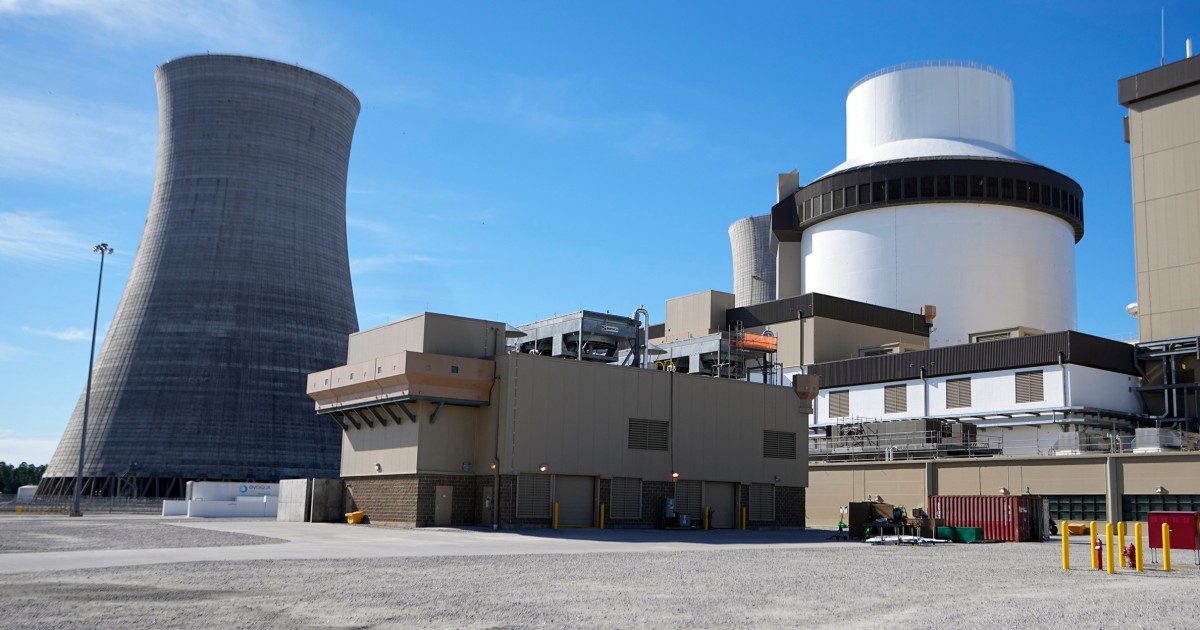First U.S. nuclear reactor built from scratch in decades enters commercial operation in Georgia::ATLANTA — A new reactor at a nuclear power plant in Georgia has entered commercial operation, becoming the first new American reactor built from scratch in decades.
Good news. Anything but fossil fuels at this point.
Nuclear is still fossil fuel, just not combustion. But I agree, this is good news because it helps reduce coal and gas usage.
Edit: I get it, I’m wrong. No need to repeat the same comments over and over.
Nuclear is Non-renewable, but it’s not a Fossil fuel:
A hydrocarbon-based fuel, such as petroleum, coal, or natural gas, derived from living matter of a previous geologic time.
The reduced operating emissions take 10+ years to outweigh the enormous construction emissions of nuclear. (Compared to gas.)
Fortunately the nuclear reactor can be operated for >50 years :)
Sure. But do you think Nuclear reactors will still be cheaper than renewables + storage in the 2070s? Nuclear is far more expensive per kWh than renewables, and the cost of storage is falling fast.
Good question, that one can only speculate on. IMO it’s a two part question.
First is that newly built nuclear plants are expensive. So the question depends on if we bite the bullet (build the reactor) today or in 2070. One built today will produce cheap power in 50 years.
For example in Finland we have reactors from 1980, that make up the backbone of stable energy production in our country. Those are going to be kept online till the 2050s. I’d argue at that point the cost per kwh will be mostly dependent on maintenance and fuel, so relatively small.
Wind and solar cannot reap the same benefits if you have to replace the plant every 20 years.
Storage is a completely separate question that is not taken into account when new wind farms and such are being built. If one was to account for storage today, the cost of renewables would be much closer to that of other means of production.
Also in the future, if storage costs keep falling due to billions of R&D money, similar effects could be achieved in nuclear via serial production and scale.
EDIT: Just read you have studied this stuff for real. Then ignore most of what I said, as you might know better :D
It was started a decade ago and finished now, not in the 2070s
deleted by creator
I literally studied this exact nuclear design at University - the Westinghouse AP1000. You can look up the WNISR (World Nuclear Industry Status Report) if you don’t want to take my word for it.
Don’t forget, mining and enriching uranium still has a significant carbon footprint, far higher per tonne than any fossil fuel. Yes, it’s lower over time, but we need to be reducing emissions now, not in 50 years time.
Yeah I hate how laxness about fixing this in a timely manner has somehow convinced some people that shit like “carbon nuetral by 2070” is ok and helpful. And I’m just remembering when that study came out that said the climate as we know it is probably gone forever if we aren’t totally carbon nuetral by at least 2030
Very good news. Nuclear power simply has way more benefits over fossil fuels. Not to mention it’s statistically safer, despite what decades of anti-nuclear sentiment has taught the public.
It’s pronounced NOOK-YOU-LERRR
Good to see industrial self sufficiency coming back to the US
Ooh a lot of people here seem very pro-nuclear-power. That’s cool!
Unfortunately, there’s still that one guy in the comments trying to say that hypothetical, largely unproven solutions are better for baseload than something that’s worked for decades.
That or the fear-mongering talking points. That’s what caused our local power plant to be decommissioned, and now those same people are complaining about how much their electrics cost now.
If you mean renewables by that, it’s hardly hypothetical or unproven. I’m in Australia and south Australia and Tasmania (two of our states) have fully renewable grids, Tasmania for the past 7 years. South Australia does still occasionally pull from an interconnect but most of the time they’re exporting a bunch of power.
Renewables with storage are cheaper and faster to build than nuclear and that’s from real world costs. Nuclear would be fine if it wasn’t so stupidly expensive.
Tasmania
Generates nearly all its power using hydro electric, which is great but pretty dependent on geography.
South Australia
Wiki says a pretty big hunk of that is still gas
In Ontario Canada where I am from it would take > 4000 wind turbines all working at once (not including the batteries) to supplant our nuclear capacity. Even the largest battery storage are in the hundreds of mega watts and only for a few hours at the cost of about half a billion dollars.
I think it is more productive to approach these technologies as complementary as any proper grid should have both for the near future if we want to reduce global warming.
Ah sorry, my mistake on that one. Despite how many wind turbines working at once it may take, the power from the is cheaper by a long shot than nuclear.
The reason I don’t think nuclear is the main solution is just cost + build time. It’s horrendously expensive. Much more so than the cost of renewables with proper grid integration (transmission, storage etc.) that has been modelled.
Maybe in a while the small nuclear reactors may come close, but currently the full sized reactors are too expensive and smr’s aren’t really a thing yet because of cost.
If power prices can come down instead of go up it’s going to be a lot easier to convince everyone to transition away from fossil fuels, and from modelling that’s been done (e.g. by csiro) that can be the reality
The nuclear lobby is alive and well on social media. Never before has the internet apparently agreed on something so controversial with some of the most cookie cutter, copy and paste, AI generated comments on the subject I’ve ever seen.
The talking points seem to gloss over the fact that nuclear storage always fails, meltdowns happen, and you still have to mine uranium out of the ground. It’s far from a clean source of energy.
That the “nuclear lobby” is paying people to post stuff on Lemmy, a social media platform that accounts for a small part of single percent of all social media users, is a hot take I haven’t heard yet. Congrats, you’ve definitely imagined a scenario that nobody else in history has ever thought of. A true original thought.
Pity it’s an absolutely fucking brain dead take masquerading as something more than nonsensical blithering from a total nincompoop, but you should bask in this moment nonetheless.
It’s not the cleanest, but in term of CO2 and other toxics produced per Giga-Watts, it’s the best compromise.
Fission is hopefully, coming in the next decades. Like the other guy said, anything but coal/petrol.
Nuclear power is something we should be using if you support science. If you don’t support science well you have a lot of other problems. Nuclear and renewable energy both need massive investments at the same time to replace fossil fuels.
I’m all for investing in other forms of energy beyond fossil fuels, this is good news to me.
Yeah, after literally bankrupting Westinghouse and costing us Georgians billions of dollars. I’m all for more nuclear power but this project was a colossal shitshow.
Georgia also has some shiny new solar factories so I’m interested to see how deep into renewables we can get in the next decade.
Whoa. Finally a state in the US that isn’t doing something completely ass backwards. We need more of this.
It’s Georgia, though. This is a positive development but it barely begins to make up for how much other ass-backwards stuff there is.
This is the state that elected Marjorie Taylor Greene, keep in mind.
A single congressional district within that state elected Marjorie Taylor Greene lol
Hmm if we had a giant solar array in space that could continuously capture sunlight, we could connect it to the Jewish Space Laser™ and beam it down to Earth, hopefully to a collection panel and not to the California forests to cause wildfires.
14 years and 35 billion (combined with #4 which has not been finished) and didn’t generate a single kWh in anger until now. Put the same investment into renewables and it would generate similar or greater energy and would start doing so within a year.
The argument against nuclear now is not about safety. It is about money. Nuclear simply cannot compete without massive subsidies.
Renewables and nuclear are in the same team. It’s true that nuclear requires a greater investment of money and time but the returns are greater than renewables. I recommend checking this video about the economics of nuclear energy.
That video completely ignores decommissioning costs for nuclear power plants and long-term nuclear waste storage costs in its calculation. Only in the levelized cost of electricity comparison does it show that nuclear is by far the most expensive way of generating electricity, and that it simply can’t compete with renewables on cost.
People love to look at nuclear power plants that are up and running and calculate electricity generation costs based just on operating costs - while ignoring construction costs, decommissioning costs, and waste disposal costs.
The cost of storing nuclear waste for a running plant is only a few hundred thousand a year; basically just just salary for a few people to transport it to a big hole in the ground.
Decommissioning costs a few hundred million, which sounds like a lot, but for a project that lasts for decades it’s basically nothing.
You could probably fit all of the nuclear waste America produces in few trucks. It’s not as much as people think.
The Department estimates that continued operation of the current fleet of nuclear power reactors could ~70,000 metric tons of uranium * increase the total inventory of spent fuel from 70,000 metric tons of uranium to 140,000 metric tons of uranium. Nearly all of this spent fuel is being stored at the reactor sites where it was generated, either submerged in pools of water (wet storage) or in shielded casks (dry storage). The Dept of Energy
Those must be some big fucking trucks. And as far as I know, only Finland has actually developed any long-term storage which could be considered safe.
Nuclear is fine, but nuclear fanboi takes are similar to weed fanbois, it’s not a perfect solution.
You seem to think a big number means a big pile of green goo. But actually…
All of the used fuel ever produced by the commercial nuclear industry since the late 1950s would cover a whole football field to a height of approximately 10 yards.
The question of nuclear waste, hammered home by the anti-nuclear crowd, has long since been answered. And the answer is: it’s far from being a problem.
As for the cost of storage and decommissioning, it makes no sense if we do not give a financial order of magnitude.
At French current electricity price, a 915MW reactor will produce 1.1 billion euros of electricity over one year. A 1500MW reactor will produce 1.8 billion euros of electricity over one year.
When you sell 60 billions of euros worth of electricity per year for 60 years, even if you pay 50 billions for storage and 2 billions to decommission an entire plant, it’s still quite profitable.
France was able to output 2 reactors per year at 1,5 billion of euros per 1000MW for more than 2 decades during the 70’s to 90’s. The whole French nuclear industry has cost around 130-150 billions between 1960 and 2010, including researches, build and maintenance of France’s whole nuclear fleet.
A 1000MW reactor, at current French electricity price and for a 80% capacity factor, generates 1,4 billion of euros worth of electricity per year, for a minimum of 60 years.
Nuclear is not costly, and can absolutely compete by itself, if you don’t sabotage it and plan it right.
I would be very interested to know why the trend has moved away from building reactors in time and within a reasonable budget. It seems that most projects after the turn of the millennium haven’t been cost effective.
Why did we manage to build reactors well before but not now?
Every year a reactor operates is a year of experiencing new ways they suck. The fixes and added complexities are rolled into the next reactor.
Thr grifters running the show also learn new ways to grift, so the small new delays and costs are amplified.
For older reactors the costs this imposes are rolled into operational budgets (and more often than not reactors are closed as unprofitable and the public or ratepayers are left holding the bag).
Additionally regulatory agencies keep finding new instances of fraud, stopping these adds costs to the regulator and regulatee.
This has happened since well before three mile island, so all misdirections to “scare mongering about meltdowns” are lies (the rate of cost escalation actually slowed significantly after three mile island).
Chernobyl and Fukushima. These two events, which between them account for a few thousand deaths at most (compared with the tens of thousands of deaths caused by coal in Europe alone, for example), triggered a panic fear of nuclear power.
For decades, the nuclear industry has been abandoned and sabotaged, with projects such as Phénix, Superphénix and Astrid in France, and virtually all new reactor projects, cancelled due to anti-nuclear opposition.
Competent nuclear engineers and technicians have retired without being able to pass on their know-how, and cutting-edge nuclear-related industries have disappeared or been converted.
We can also thank the Germans for sabotaging the EPR. We started the project together, they forced us to add a lot of totally unjustified redundancies and safety features that made the prototype very complex and therefore costly to build, and then they slammed the door on us.
Competent nuclear engineers and technicians have retired without being able to pass on their know-how, and cutting-edge nuclear-related industries have disappeared or been converted.
This same fear has been enough to fund SLS and Ariane programs. Basically to avoid the loss of a capability in case it’s needed later on. For some reason it doesn’t seem to apply to nuclear. And now people are complaining that building new reactors is expensive, arguably at least partially due to the supply chains no longer existing in the same scale as before.
If loss of expertise were the cause, then there would have been a cost minimum in the late 80s when the maximum number of engineers had 5-15 years of experience.
Instead costs rose for each new reactor (including repeat builds of each model).
This theory has no explanatory power over reality and predicts the opposite of what happened.
Should the delays and subsequent costs overruns then be simply attributed to increased regulatory complexity or corporate greed?
I’m looking at the list of reactors in France, most of the builds during the last millennium were completed in more or less 10 years. Then there was a gap, and the new one is taking way longer than previous ones.
Same thing has happened in many other countries. Including finland, where at first we got 4 reactors in 6-10 years, and then after a gap of 25 years the next reactor was a clusterfuck that took almost 20years to build.
Both of these reactors are of the same design, and the issues are at least partially attributed to the company having forgot how to manage such large projects due to the years long gap in construction.
Part is the neoliberal economic model is really really bad at big projects. Part is the regulations and engineering complexity involved in not having them all shut down because they caught fire or the steam generators corroded (almost every program has “cheap” reactors at the beginning which have massive maintenance issues and leaks 10-30 years later, followed by expensive ones with massive delays). Part is corporate greed. Part is revealing and stopping rampant fraud and finding safety-compromising cost-cutting measures. Part is the lack of pressure from the military to make it happen as there is no longer a need for as much Plutonium. Part is that there actually are some semblance of environmental laws. Part is the fossil fuel industry interfering (as they do with all non-fossil-fuels).
Except those reactors are off 30-50% of the time due to shoddy construction, €1.5/W in 2023 money is pure fiction, and overnight costs with free capital aren’t real costs once you adjust for inflation and stop cherry picking the first reactors before negative learning rates kicked in.
Except those reactors are off 30-50% of the time due to shoddy construction
For French nuclear power, the lowest load factor ever recorded is 54% in 2022. The cause is the number of maintenance operations postponed because of COVID, plus a corrosion problem detected on several reactors of the same generation, which have since been repaired.
- This is an extremely unlikely combination of circumstances, on the one hand
- On the other hand, it wouldn’t have had any consequences if we’d had more redundancy, and hadn’t suddenly stopped building reactors for 25 years.
- Despite this, nuclear power still has a load factor 2x higher than French wind or solar power.
The rest of the time, the load factor of French nuclear power hovers around 70-75%, and that’s not due to bad design, it’s a strategy. I’ll let you read this link to learn more.
€1.5/W in 2023 money is pure fiction
Of course it does. But the fact is that french nuclear power has paid for itself dozens of times over. It’s factual, it’s historical.
and overnight costs with free capital aren’t real costs once you adjust for inflation and stop cherry picking the first reactors before negative learning rates kicked in.
Yes it was a “strategy” for EDF to go tens of billions into debt, and the other 30-50% of french power infrastructure is there just for fun. These mental gymnastics are incredibly tiresome.
Responding to sarcastic, disrespectful and immature one-liners from someone obviously ignorant on the subject is neither exciting nor productive, so I’ll just throw out a few points in response to your last comment without bothering to expand on them and then move on.
- With the exception of 2010, EDF made a net profit of 2 to 5 billions a year between 2005 and 2021.
- EDF and its predecessors were public bodies, and were forced by the State to take over unprofitable activities.
- ARENH
- Tariff shield + European gas-indexed electricity market
More deranged doublethink.
ARENH can’t be causing losses if the price it sets is profitable (so by citing it you are claiming that the french nuclear fleet has never broken even).
It also can’t be causing a production shortfall requiring buying expensive hydro if the reactors are off because of a “strategy”.
Your debt doesn’t go up every year if you’re making a profit.
Deferring maintenance doesn’t make costs magically vanish.
Decomissioning, waste management and hundreds of billions for license extensions are also completely unfunded. So the french people were just bilked another €10 billion for taking on a larger share of a half trillion dollar liability.
deleted by creator
I highly, highly recommend the Oliver Stone documentary Nuclear Now from earlier this year. Completely changed my perspective. I had no idea that the oil industry was behind so much of the fear mongering around nuclear.
I mean, it’s obvious.
Also historically some of Soviet-friendly left would present “capitalist” nuclear energy as apocalyptic-level dangerous and related to nuclear weaponry etc (cause USSR was, after discovery of reserves, selling oil and gas just like Russia does now, actually that was the reason for Brezhnev’s time improvement in level of life and simultaneously rapid growth of corruption, also loss of hope of anything like the Thaw happening again).
Or, maybe people recognize that literally the majority of radioactive mining leaves irradiated lands that disproportionately effect minorities and oppressed communities. The Navajo are still suffering due to the mining of radioactives in their area. The same story is true for nearly every community near such facilities.
while that is certainly an issue, i very much doubt that it is a primary reason (or even remotely a concern) for the average anti-nuclear layperson.
Ah, those activists wouldn’t talk about that mostly, they’d talk about boom and radioactive pollution in places their audience lived in.
Leftists caring about minorities and oppressed communities anyplace far from themselves are a notable rarity.
And since the replacements were coal, oil and gas, which are just as dirty, I’d say your argument isn’t worth shit.
That’s funny.
So you’re willing to move within 1 mile of a uranium mine and live there and drink the well water from that property?
Or are you just willing to sacrifice others for your luxurious lifestyle?
There are alternatives other than continuing to expand our consumption of fossil or nuclear fuels. Hell, most of them don’t even require lifestyle changes from the majority of the population.
So you’re willing to move within 1 mile of a uranium mine and live there and drink the well water from that property?
No, but it’s the same with gold mines, copper mines, coal, ohoho, oil, ahaha, etc. Scale matters, and in scale for the same amount of energy nuclear gives the least pollution.
Also I invite you to live near a lithium mine.
Or check it, we don’t increase our consumption, so we don’t need more energy. We purposefully decrease it. We allocate resources by necessity.
Widget factories don’t need to operate 24 hours a day, and their owners don’t need to make 500x their employees wages. Kill two birds with one stone, the widget factory is only allocated enough energy to run a few hours a day, and the wages from its executives (who have proven they don’t deserve it by the very lack of care towards sustainability they have presented) go to the workers to ensure they continue to make the same amount despite the decrease in work time.
You do that with all of the industries in the world, and I guarantee we could cut emissions by 50% within a year. Obviously, global implementations are much more complicated than my comment would imply, but I think accepting an end to a system where the only limits placed upon industry is “how much money do you have?” Is necessary entirely to have even a fraction of a chance at beating climate change.
Then, once we’ve stopped wasting massive amounts of energy on inherently useless endeavors, then we can start to talk about the pollution caused by nuclear, but until then, it’s just replacing one extractive industry with another. Whether or not in theory nuclear is less damaging environmentally, our current Money = Right system precludes the possibility of such sustainable practices being put into place. There is always another country that can be corrupted to allow destructive, cheap extraction processes, like what happens in Mail, Burkina Faso, and Niger as we speak.
To be fair we have seen multiple disasters in the past including Chernobyl, Three Mile Island, and Fukushima, which have serious and long lasting effects. I’m not against nuclear power but we can’t pretend the downsides are just made up or blown out of proportion.
They are sort of blown out of proportion when you take into account modern safety protocols.
Chernobyl and three mile island were user error, fukushima was force majeure.
Since then they’ve been piloted widely. France has about 50 reactors and a laundry list of smaller errors that we’ve since learned from.
Have you ever compared the impact of Fukushima compared to the tsunami that caused it?
Other than that, even if we assume rectors keep being old tech from the 60s, never using newer generations of rectors that can be inherently safe: Who cares about a bit of contaminated area, very localized, every few dozen years, when the alternative is a global climate crisis?
More people died in the evacuation of Fukushima than died fighting the meltdown, which was arguably 1.
1 confirmed from radiation (lung cancer, 4 years later),[3] and 2,202 from evacuation.[4]
The tsunami killed over 15,000 people. Awful disaster.
However, Japanese people are very anti-nuclear so their media made it seem that the impact was horrific when, aside from the exclusion zone, wasn’t all THAT bad. However, losing that land was a big hit to a small country.
what does built “from scratch” mean? Just a more emphatic way of saying “built?” Or that it wasn’t repurposed out of some already built building?
Outstanding!
About damn time! As a Georgia Power ratepayer, I’ve only already been paying extra for it for what, around a decade now?
That’s the downside of nuclear. Cost and build time. Upside is it’s reliable and carbon-clean.
The best time to build a nuclear power plant was thirty years ago. The second best time is now.
Oh, neat. My state did something not completely stupid. I’ve got some reservations about nuke power as opposed to renewable, but this is definitely better than continuing fossil fuels.
Too bad the energy companies essentially never dispose of the waste properly, because it’s too expensive if they want to give the huge bonuses to their CEOs and buyback thie stock. Even when doing it “properly” it’s basically just making it the problem of future generations once the concrete cracks.
And to reprocess the waste and make it actually safe energy would mean no profit at all plus the tech doesn’t exist yet to actually build the reactors to reprocess the waste. I mean we understand the theory, but it would take at least a decade to engineer and build a prototype.
Compare that to investing in battery tech which would have far reaching benefits. And combining that with renewables is much more profitable.
Too bad the energy companies essentially never dispose of the waste properly
To be fair, nuclear waste tends to be disposed of much more properly than coal waste.
True, but still not anywhere near “clean” as it’s always marketed as.
Not a single power source we have is clean
How is solar, wind, or hydro not “clean”? The generating of the power, not the building of the facilities, building anything is never clean.
People count material, fuel and ecological with nuclear as well, so why not count it with hydro, wind and solar? Concrete is concrete.
Because all technology will require that. If we want energy, we have to build stuff. But there’s no fuel to buy, generally much less ecological impact due to limited waste products since no fuel is being “burned”. And the building cost is one time and generally subsidized, and maintenance is considerably lower, not to mention labor since you don’t need nuclear specialists to run the day to day.
What makes you say that. Nuclear waste has the consistency of glass or sand depending on how it’s processed. And if we reprocessed that waste like the French we could effectively remove the danger of it.
See earlier in the thread. The waste is highly radioactive, of course, and very hot for some time. First it is dumped in pools. If the pool floods or cracks, you end up with the Fukushima issue. Fortunately that went to the ocean primarily and so was diluted. But in the US, much of the country is landlocked and it would instead enter ground water.
Second, once the material is cooled enough to transport, it is supposed to be moved to a secure location, dropped deep into the ground, and encased in concrete. At this point if there are no earthquakes and water doesn’t enter and damage the concrete, this will stay put for a thousand years or so, but eventually it will get out long before it’s safe considering some of it takes around 250,000 years for it to decay enough to be safe.
As for what France does, as I mentioned, the US has not developed or built that tech because there is ultimately no profit in it and the US is unwilling to spend tax money on it. So it would fall to increased energy cost for the consumer in places where nuclear is used, and no one is going to like that. The cost of building the reprocessing facilities and doing the actual processing outweighs the value of the produced product. And building the first one is going to be the most expensive, and no modern energy company is likely to want to take the hit to short term stock prices in order to take it on. And conservatives won’t approve tax increases at all in the current political climate. And progressive places have already started moving to renewables instead since it’s cheaper.
As for what France does, as I mentioned, the US has not developed or built that tech because there is ultimately no profit in it and the US is unwilling to spend tax money on it.
First Ford, then Carter stopped commercial re-processing in the United States. Reagan brought it back. G. H. W. Bush then put the brakes on it but stopped short of an outright ban. Clinton stepped on the brakes even harder but again stopped shy of a full ban and when Bush Jr came into office he started a slow process of bringing it back. That’s as far as this CRS Report goes although there may be an updated one somewhere out there.
Still, the US has spent money on it and was doing so at least as recently as 2008. It appears the biggest worry we have is proliferation of nuclear material, not profit or cost.
The problem is that by the 80s and 90s we were trying to wind down production of nuclear weapons as the cold war was winding down. Some of these reprocessing methods, like in France, reprocess the plutonium, and modern reactors just don’t produce plutonium anymore. Also, some of the methods create uranium that is enriched to as much as 20%. With terrorism a big concern, that would be a pretty tempting target.
That being said, we are developing the tech, just very, very slowly. And now that renewables are cheap, it’s just not necessary to have so many fueled generators. So the long term profit just isn’t there for companies to want to invest. The area where I live is primarily hydro power, which is one of the more predictable renewables. But offshore wind farms give a pretty steady flow as well. And in deserts concentrated solar power can generate enough energy during the peak times when A/C is being used. And if there were better battery tech, more could be stored for use at night than currently is, and wind is still pretty reliable due to the changes in temperature from day to night.
Of course we still need fueled generators, but we shouldn’t be expanding them, we should be concentrating on using them only as a backup to renewables.
This is a stupid take.
Coal power puts out more radioactive waste than nuclear does, and coal sends it right into the air where we can’t manage it.
Nuclear waste is kept solid, and contained. We know exactly where it goes and as long as the rules are followed it’s not at risk of polluting anything.
Sure solar and wind don’t have any by product once they are setup, but they also don’t fit the baseline power need that nuclear does.
Problem is it’s not profitable to follow the rules, and conservatives have blocked building a national “permanent” storage site for decades. The IS has no where to put it. It’s just sitting in storage facilities, above ground and in many states in places where an earthquake could cause it to leak into ground water and make the area unlivable for centuries, or cost trillions to clean up.
https://www.scientificamerican.com/article/nuclear-waste-is-piling-up-does-the-u-s-have-a-plan/
Quite a large number of Republicans, including Trump himself, spend decades trying to ram Yucca mountain through. It faced heavy resistance from both the Clinton and Obama Administrations, the State of Nevada, and myriad of environmental organizations. Trying to blame it on “Conservatives” is pretty ridiculous.
https://www.ktnv.com/news/history-of-yucca-mountain-1982-2018
Yucca Mountain was killed by decades of persistent interference by opponents of nuclear power.
Yucca Mountain was a bad site. Once they started digging they found that the ground was too loose. It wouldn’t be able to support the weight without sinking. Have you ever seen the foundation of a house that sank on one side? The concrete buckles as the weight of the house slowly compacts the soil. The same thing will happen with millions of tons of waste, steel, and concrete. It’s why missile silos were built in bedrock, not loose soil. Not to mention the technology wasn’t going to allow digging deep enough to store all that much. It would mostly be used for waste from nuclear weapons, ship reactors, and other military projects. Not really that much space would have been available for commercial power generator use.
The conservatives who pushed for it did it because the contractors paid them to. It was blocked because the waste would leak not in thousands of years but in maybe decades. Not to mention the land was stolen from Native Americans and they didn’t want nuclear waste in their stollen land. Among many other issues.
Edit: besides the Clintons have always been conservatives, too. So they’re in that bucket. They’re just moderates.
Fission and fusion reactors are really more like in-between renewable and non-renewable. Sure, it relies on materials that are finite, but there is way, way more of that material available in comparison to how much we need.
Making this distinction is necessary to un-spook people who have gone along with the panic induced by bad media and lazy engineering of the past.
Fusion and fission are quite different. A practical fusion reactor does not exist. It’s outside our technological capability right now. Current fusion reactors are only experimental and can not maintain a reaction more than a small fraction of a second. The problem is plasma containment. If that can be solved, it would be possible to build a practical fusion reactor.
The fuel for a working fusion reactor would likely be deuterium/tritium which is in effect unlimited since it can be extracted from seawater. Also the amount of fuel required is small because of the enormous amounts of energy produced in converting mass to energy. Fusion converts about 1% of mass to energy. Output would be that converted mass times the speed of light squared which is a very, very large number, in the neighborhood of consumed fuel mass times 1015.
Fusion is far less toxic to to the environment. With deuterium/tritium fusion the waste product is helium. All of the particle radiation comes from neutrons which only require shielding. Once the kinetic energy of the particles is absorbed, it’s gone. There’s no fissile waste that lingers for some half life.
Your info is a little out of date - some fusion experiments have been able to maintain fusion for almost a minute. However, your point still stands. We are decades away at a minimum untill a viable fusion reactor.
My guess is that fusion will be too expensive for commercial use unless they can get a super compact stellarator design to produce huge amounts of energy, and make them cheap to build (HA!).
Or we will see them in spaceships. :P
We don’t even know if fusion will ever be functionally able to produce more energy than it consumes, and on top of that it will need to be less expensive than natural gas or solar in order to compete. Which it will never do. Do you have any idea how much ITER has cost?
$22 billion, or $16 billion “over budget.” And this is a test reactor that will never produce commercial power. They still have 2 years of construction left so… it could hit $30 billion. At least at Vogtle they are getting two reactors.
We can still categorize a concept, even if the technology doesn’t exist in a useful state yet.
redacted
I’m spooked by the fact that you have no idea how the US enriches uranium, or the difference between a power pressurized water reactor and a fast “breeder” reactor (if you were thinking of plutonium) or a centrifuge.
The US enriches uranium using a gas-centrifuge. The US also no longer recycles spent nuclear fuel, but France does.
redacted
Sure, it relies on materials that are finite, but there is way, way more of that material available in comparison to how much we need.
Not trying to be “difficult,” but isn’t that what people thought about coal/oil at first? I understand that the scale is different, but it still needs to be a stop gap as opposed to a long term plan.
Spent Nuclear Fuel, unlike coal or oil, can be recycled to a certain extent (this is done in places like France but not the US). If we recycled all of the spent fuel, we’d potentially have a thousand years (give or take) of fissionable fuel. Plenty of time for us to get fusion running so we can completely wean ourselves off petroleum energy generation.
You’re conflating leftover dregs of Pu-239 (about a 10-15% boost in energy per fuel input) with non-fissile material like U238. Breeder reactors required to use the second have never been used commercially in breeding mode.
You’ve either fallen for or are intentionally spreading a lie.
What lie am I spreading? Conventional Light Water Reactor Nuclear Fuel (5-6% U-235 w/t%) can be recycled. This can be done even without using breeder reactors which operate through fast fission of U-235
Yes the plutonium can be stripped out along with the other transuranics, and it does pose a proliferation risk (separate issue), but it definitely can be recycled. France reprocesses their fuel.
Edit: typo correction
Ah. So intentional then. You’re trying to pretend extracting the <0.7% left over U235 and Pu239 (for a 10-15% increase in U235 fuel economy) is somehow fissioning U238.
I don’t understand what you’re trying to say here. Reprocessed fuel does not imply that we’re now fissioning U-238. That takes place in a completely different energy regime (fast fission vs. thermal). Light Water Reactors and fast reactors operate differently, with different fuels. LWRs in commercial operation use slightly enriched U-235. There is no fissioning of U-238 other than the very small amount of spontaneous fission which is negligible compared to contributions from thermal fission in an LWR. The Six Factor formula governs criticality reactions, and these terms differ for both reactor types. The nuclear cross sections are fundamentally different between these energy regimes.
Reprocessed fuel is what it implies, recycled processed LWR fuel, stripped of the fission products that built up as the fuel underwent burnup in the core. If this were some sort of pretend activity then I guess the entire reprocessing back end of the nuclear fuel industry is fake.
I don’t appreciate the personal attacks, so if you have nothing constructive to say, good day to you sir slash madam.
Why do you think we need nuclear to transition fully off petroleum? Renewables with storage are cheaper today for new build power, let alone in another 20 years. They continue to get cheaper and more efficient quite rapidly.
Adding to what others have said here, nuclear is great for base load consumption. Use the renewables to supplement during peak hours where load variability is the greatest.
Sure, you could connect renewables to batteries / accumulators for times when they are not available (i.e. no wind, no sun) but this doesn’t give a very good consistent base load. A nuclear plant that is 1 MWe will always give 1MWe if it is up all the time. I’m not saying here that batteries aren’t a good option, just that they aren’t the optimal solution.
Another thing to consider is resistive transmission losses. Connecting long cables from, say offshore wind farms or areas of high wind density, to electrical substations long distances away makes delivering the electricity more inefficient. Granted, having it is better than not (nobody likes brownouts). But engineers try to take all of these into consideration when working on the regional power grid.
Wait… is this the USA’s first Gen III+ reactor?
It looks like it!
Looks like the only completed Gen 3 nuclear reactors are in Asia, at Kashiwazaki (Japan), Kori (South Korea), Yangjiang, Fangchenggang, Tianwan (China), and Kudankulam (India).
Edit: I missed the Gen III+ part of that Wikipedia page. The other currently operation or under construction Gen 3+ reactors are in Sanmen, Shidao Bay, Taishan (China), Novovoronezh II, Leningrad II, Kursk (Russia), Akkuyu (Turkey), Rooppur (Bangladesh).
Nice!




















